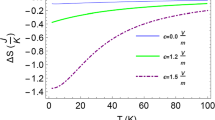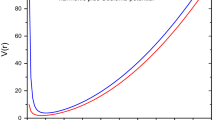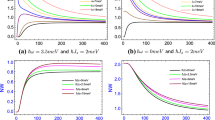Abstract
In this work, we consider a quantum dot in the presence of electric and magnetic fields simultaneously. The Schrodinger equation is analytically solved, and energy levels and eigenstates are determined. Then, we have calculated the changes in entropy using the non-extensive formalism. To this end, we have used the Tsallis entropy formalism to study the electrocaloric effect (ECE). Here, we have investigated the ECE of the system and determined the influence of system parameters on the ECE. Our attention of the work is to study the effect of temperature, electric field, magnetic field and, non-extensive parameter in the ECE. It is found that the aforementioned parameters have important roles on the ECE. We could obtain both normal and inverse the ECE by changing the parameters. This behavior can be employed for tuning the properties for particular applications.






Similar content being viewed by others
References
Atoyan, M.S., Kazaryan, E.M., Sarkisyan, H.A.: Interband light absorption in parabolic quantum dot in the presence of electrical and magnetic fields. Phys. E 31, 83–85 (2006)
Attar, F., Khordad, R., Zarifi, A.: Determination of vibration of single-layered graphene sheets using nonlocal modified couple stress theory. Int. J. Mod. Phys. C 33, 2250011–2250019 (2022)
Bhattacharyya, T., Cleymans, J., Mogliacci, S.: Analytic results for the Tsallis thermodynamic variables. Phys. Rev. D 94, 094026–094031 (2016)
Boyacioglu, B., Chatterjee, A.: Heat capacity and entropy of a GaAs quantum dot with Gaussian confinement. J. Appl. Phys. 112, 083514–083520 (2012)
Burkard, G., Loss, D., DiVincenzo, D.P.: Coupled quantum dots as quantum gates. Phys. Rev. B 59, 2070–2075 (1999)
Caruso, F., Tsallis, C.: Nonadditive entropy reconciles the area law in quantum systems with classical thermodynamics. Phys. Rev. E 78, 021102–021109 (2008)
Cortes, N., Negrete, O., Pena, F.J., Vargas, P.: Gate-tunable charge carrier electrocaloric effect in trilayer graphene. Sci. Reports 11, 22000–22010 (2021)
Diffo, T.V., Fotue, A.J., Kenfack, S.C., Keumo Tsiaze, R.M., Baloitcha, E., Hounkonnou, M.N.: Thermodynamic properties of a monolayer transition metal dischalcogenide (TMD) quantum dot in the presence of magnetic field. Phys. Lett. A 385, 126958–126963 (2021)
Edet, C.O., Ikot, A.N.: Shannon information entropy in the presence of magnetic and Aharanov-Bohm (AB) fields. Eur. Phys. J. plus 136, 432–440 (2021)
Guo, K.X., Chen, C.Y., Das, T.P.: Studies on the third-harmonic generation of double-layered quantum wires in magnetic fields. Opt. Quant. Electron. 33, 231–237 (2001)
Hayrapetyan, D.B., Kazaryan, E.M., Kotanjyan, T.V., Tevosyan, H.K.: Exciton states and interband absorption of cylindrical quantum dot with Morse confining potential. Superlatt. Microstrut. 78, 40–49 (2015)
Hoffmann, M., Schroeder, U., Kunneth, C., Kersch, A., Starschich, S., Bottger, U., Mikolajick, T.: Ferroelectric phase transitions in nanoscale HfO2 films eneable giant pyroelectric energy conversion and highly efficient supercapacitors. Nano Energy 18, 154–164 (2015)
Jia, C.S., Li, J., Liu, Y.S., Peng, X.L., Jia, X., Zhang, L.H., Jiang, R., Li, X.P., Liu, J.Y., Zhao, Y.L.: Predictions of thermodynamic properties for hydrogen sulfide. J. Mol. Liq. 315, 113751–113756 (2020)
Khordad, R.: Effect of temperature on magnetic susceptibility and thermodynamic properties of an asymmetric quantum dot in tilted magnetic field. Mod. Phys. Lett. B 29, 1550127–1550132 (2015)
Khordad, R., Rastegar Sedehi, H.R.: Application of non-extensive entropy to study of decoherence of RbCl quantum dot qubit: Tsallis entropy. Superlatt. Microstruct. 101, 559–566 (2017)
Khordad, R., Rastegar Sedehi, H.R.: Low temperature behavior of thermodynamic properties of 1D quantum wire under the Rashba spin-orbit interaction and magnetic field. Solid State Commun. 269, 118–124 (2018)
Khordad, R., Rastegar Sedehi, H.R.: Thermodynamic properties of a double-ring shaped quantum dot at low and high temperatures. J. Low Temp. Phys. 190, 200–212 (2018)
Liang, D.C., Zeng, R., Wang, C.W., Ding, Q.C., Wei, L.S., Peng, X.L., Liu, J.Y., Yu, J., Jia, C.S.: Prediction of thermodynamic properties for sulfur dioxide. J. Mol. Liq. 352, 118722–118728 (2022)
Liu, Y., Peng, X.P., Lou, X., Zhou, H.: Intrinsic electrocaloric effect in ultrathin ferroelectric capacitors. Appl. Phys. Lett. 100, 192902–192908 (2012)
Liu, Y., Scott, J.F., Dkhil, B.: Direct and indirect measurements on electrocaloric effect: recent developments and perspectives. Appl. Phys. Rev. 3, 031102–031112 (2016)
Loss, D., DiVincenzo, D.P.: Quantum computation with quantum dots. Phys. Rev. A 57, 120–128 (1998)
Lu, S.G., Zhang, Q.: Electrocaloric materials for solid-state refrigeration. Adv. Mater. 21, 1983–1987 (2009)
Mischenko, A.S., Zhang, Q., Scott, J.F., Whatmore, R.W., Mathur, N.D.: Giant electrocaloric effect in thin-film PbZr(0.95)Ti(0.05) O3. Science 311, 1270–1271 (2006)
Nammas, F.S.: Thermodynamic properties of two electrons quantum dot with harmonic interaction. Phys. A 508, 187–198 (2018)
Neese, B., Chu, B., Lu, G., Wang, Y., Furman, E., Zhang, Q.M.: Large electrocaloric effect in ferroelectric polymers near room temperature. Science 321, 821–823 (2008)
Park, M.H., Kim, H.J., Kim, Y.J., Moon, T., Kim, K.D., Hwang, C.S.: Toward a multifunctional monolithic device based on pyroelectricity and the electrocaloric effect of thin antiferroelectric HfxZr1-xO2 films. Nano Energy 12, 131–140 (2015)
Park, M.H., Kim, H.J., Kim, Y.J., Moon, T., Kim, K.D., Lee, Y.H., Hyun, S.D., Hwang, C.S.: Giant negative electrocaloric effects of Hf0.5Zr0.5O2 thin films. Adv. Mater. 28, 7956–7961 (2016)
Park, M.H., Schenk, T., Hoffmann, M., Knebel, S., Gartner, J., Mikolajick, T., Schroeder, U.: Effect of acceptor doping on phase transitions of HfO2 thin films for energy-related applications. Nano Energy 36, 381–389 (2017)
Park, M.H., Hoffmann, M., Hwang, C.S.: Chapter 5.2 - Pyroelectric and electrocaloric effects and their applications. In: Schroeder, U., Hwang, C.S., Funakubo, H. (eds.) Woodhead Publishing Series in Electronic and Optical Materials, Ferroelectricity in doped hafnium oxide: materials, properties and devices, pp. 217–244. Woodhead Publishing (2019)
Peng, X.L., Jiang, R., Jia, C.S., Zhang, L.H., Zhao, Y.L.: Gibbs free energy of gaseous phosphorus dimer. Chem. Eng. Sci. 190, 122–125 (2018)
Rastegar Sedehi, H.R.: Magnetocaloric effect in Rashba spin-orbit coupling and Zeeman splitting of a narrow nanowire quantum dot. Eur. Phys. J. Plus 136, 514 (2021)
Rastegar Sedehi, H.R.: Control of magnetocaloric effect in quantum dots using electric field at low temperatures. J. Low Temp. Phys. 207, 241–249 (2022)
Rastegar Sedehi, H.R., Khordad, R., Bahramiyan, H.: Optical properties and diamagnetic susceptibility of a hexagonal quantum dot: impurity effect. Opt. Quant. Electron. 53, 264–270 (2021)
Rastegar Sedehi, H.R., Arda, A., Sever, R.: Thermodynamic properties of a charged particle in non-uniform magnetic field. Opt. Quant. Electron. 53, 142–150 (2021)
Reis, M.S., Soriano, S.: Electrocaloric effect in graphenes. Appl. Phys. Lett. 102, 112903–112909 (2013)
Sirtori, C., Capasso, F., Sivco, D.L., Cho, A.Y.: Giant, triply resonant, third-order nonlinear susceptibility χ3ω(3) in coupled quantum wells. Phys. Rev. Lett. 68, 1010–1015 (1992)
Tsallis, C.: Possible generalization of Boltzmann–Gibbs statistics. J. Stat. Phys. 52, 479–487 (1988)
Tsallis, C., Mendes, R.S., Plastino, A.R.: The role of constraints within generalized nonextensive statistics. Phys. A 261, 534–554 (1998)
Wang, G.: Third-harmonic generation in cylindrical parabolic quantum wires with an applied electric field. Phys. Rev. B 72, 155329–155336 (2005)
Wang, J., Jia, C.S., Li, C.J., Peng, X.L., Zhang, L.H., Liu, J.Y.: Thermodynamic properties for carbon dioxide. ACS Omega 4, 19193–19198 (2019)
Wang, C.W., Wang, J., Liu, Y.S., Li, J., Peng, X.L., Jia, C.S., Zhang, L.H., Yi, L.Z., Liu, J.Y., Li, C.J., Jia, X.: Prediction of the ideal-gas thermodynamic properties for water. J. Mol. Liq. 321, 114912–114920 (2021)
Yahyah, N.S., Elsaid, M.K., Shaer, A.: Heat capacity and entropy of Gaussian spherical quantum dot in the presence of donor impurity. J. Theor. Appl. Phys. 13, 277–288 (2019)
Zhang, C.J., Guo, K.X.: Polaron effects on the third-order nonlinear optical susceptibility in asymmetrical semi-parabolic quantum wells. Phys. B 383, 183–187 (2006)
Author information
Authors and Affiliations
Corresponding author
Ethics declarations
Conflict of interest
The authors declare that they have no known competing financial interests or personal relationships that could have appeared to influence the work reported in this paper.
Additional information
Publisher's Note
Springer Nature remains neutral with regard to jurisdictional claims in published maps and institutional affiliations.
Appendix
Appendix
In this part, we have presented the details of the calculation of energy levels. The Schrödinger equation is expressed by
Here,
In the cylindrical coordinates, we have
where \(E_{t} = E_{\rho } + E_{z}\).
Consider the wave function as
By using above relation, we have
The solutions of the above equations are (Atoyan et al. 2006)
where \(A\) and \(B\) are the normalization constants, \(a = \sqrt {\frac{\hbar }{{m^{*} {\Omega }}}}\), \(z_{0} = \frac{e \in }{{m^{*} \omega_{0}^{2} }}\), \(F\left( {\mu ,\lambda ;x} \right)\) is the confluent hypergeometric function, and \(H_{n} \left( x \right)\) is the Hermite function. Also, \(n_{\rho }\), \(m\), and \(n_{z}\) are the quantum numbers, respectively.
Using the above wave function, the total energy is obtained as
Rights and permissions
About this article
Cite this article
Khordad, R., Sedehi, H.R.R. Electrocaloric effect in quantum dots using the non-extensive formalism. Opt Quant Electron 54, 511 (2022). https://doi.org/10.1007/s11082-022-03902-6
Received:
Accepted:
Published:
DOI: https://doi.org/10.1007/s11082-022-03902-6




